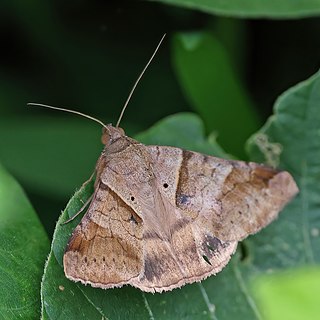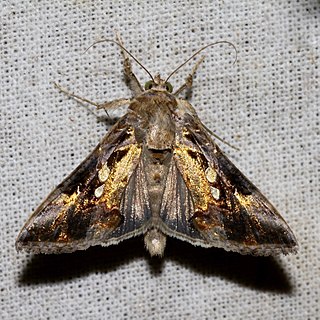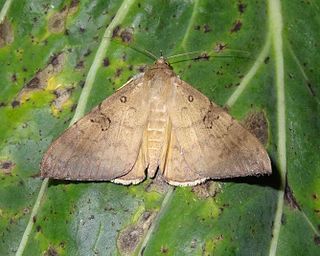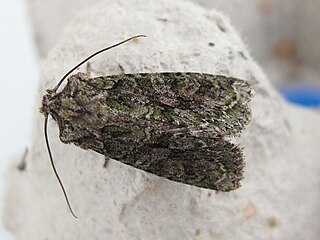
Mocis frugalis, the sugarcane looper, is a moth of the family Erebidae. The species was first described by Johan Christian Fabricius in 1775. It is found in several parts of the world, including India, Sri Lanka, West African countries and other Oriental regions. The adult is a fruit piercer and a major pest of crops.

Mocis undata, the brown-striped semilooper, is a moth of the family Erebidae. The species was first described by Johan Christian Fabricius in 1775. It is found in the Afrotropical and Oriental regions, including India and Sri Lanka.

Thysanoplusia orichalcea, the slender burnished brass, is a moth of the family Noctuidae. The species was first described by Johan Christian Fabricius in 1775. It is a polyphagous pest of vegetable crops that originated in Indonesia, from where it spread to Europe, South Asia, India, Sri Lanka, Africa, Australia and New Zealand. In northern Europe it is a migrant species.

Dordura is a monotypic moth genus of the family Noctuidae erected by Frederic Moore in 1882. Its only species, Dordura aliena, was first described by Francis Walker in 1865. It is found in the Indian subregion, Sri Lanka, Myanmar, Thailand, Peninsular Malaysia, Sumatra, Borneo and New Guinea.

Grammodes is a genus of moths in the family Erebidae first described by Achille Guenée in 1852.

Psimada is a monotypic moth genus of the family Noctuidae. Its only species, Psimada quadripennis, is found in the Indian subregion, southern China, Taiwan, Myanmar, Thailand, Sri Lanka, the Andaman Islands, Sundaland, Sulawesi and Seram. Both the genus and species were first described by Francis Walker in 1858.
Anadevidia peponis is a moth of the family Noctuidae. It is found in south-east Asia, including Japan, India. Taiwan and New South Wales in Australia. It is a minor pest on many cucurbits.

Brithys crini, the amaryllis borer, crinum borer, lily borer or Kew arches, is a moth of the family Noctuidae. It is a garden pest in parts of its range, as their larvae damage the stems and leaves of lilies, especially lilies of the family Amaryllidaceae.

Argyrogramma signata, the green semilooper, is a moth of the family Noctuidae.

Grammodes stolida, the geometrician, is a moth of the family Erebidae. The species was first described by Johan Christian Fabricius in 1775. It is found in Africa, southern Europe, most of Asia and Australia. It migrates to central and northern Europe as far north as England, Denmark and Finland.

Thyas coronata is a species of moth of the family Erebidae first described by Johan Christian Fabricius in 1775. It is found from the Indo-Australian tropics of southern China, Taiwan, Japan, Nepal, India, Sri Lanka to Micronesia and the Society Islands.

Oxyodes scrobiculata, the longan semi-looper or longan leaf-eating looper, is a moth of the family Erebidae. The common name "looper" is used despite looper moths generally being in the family Geometridae. The species was first described by Johan Christian Fabricius in 1775. It is found from the Indo-Australian tropics of India, Sri Lanka, Myanmar, China, east to Guam, Queensland, New Caledonia, Fiji, Samoa and Tonga.

Pindara illibata is a moth of the family Noctuidae first described by Johan Christian Fabricius in 1775. It is found in the Oriental region, including Taiwan, China, India, Sri Lanka, Myanmar, Japan and Borneo.

Trigonodes hyppasia, the triangles or semi-looper, is a moth in the family Erebidae. The species was first described by Pieter Cramer in 1779. It is largely cosmopolitan, found throughout Borneo, Fiji, India, Nepal, Sri Lanka, São Tomé and Príncipe, Taiwan, Thailand, Zimbabwe, northern Australia, and almost all African countries.

Chiasmia emersaria is a moth of the family Geometridae. The species was first described by Francis Walker in 1861. It is found in India, Nepal, northern Thailand, China, Sri Lanka, Japan and the Ryukyu Islands.

Dryobotodes eremita, the brindled green, is a moth of the family Noctuidae. The species was first described by Johan Christian Fabricius in 1775. It is found in most of Europe, east to Turkey.

Ischyja manlia is a species of moth of the family Noctuidae first described by Pieter Cramer in 1776. It is found in the Indian subregion, Sri Lanka, Myanmar, Thailand, China, Okinawa, Sundaland, Sulawesi, Korea, the southern Moluccas, Australia (Queensland) and Palau. Adults pierce the skin of fruit to suck the juice.

Gesonia obeditalis is a species of moth of the family Noctuidae first described by Francis Walker in 1859. It is found from eastern Africa, the Seychelles, the Maldives and the Oriental tropics of India, Sri Lanka east to the Philippines, the Sula Islands and Australia. The adult moth has brown wings with a scalloped dark brown band near the margin. The hindwings are similar in pattern to the forewings but are a paler shade of brown.
Gymnoscelis deleta is a moth in the family Geometridae. It is found in India, Korea, Japan, Taiwan and probably in Sri Lanka according to Hampson.

Sphingomorpha chlorea, the sundowner moth, is a species of moth in the family Erebidae that is native to Africa and southern Asia. The species was first described by Pieter Cramer in 1777. It is a fruit-piercing moth and a notorious pest in orchards. The fruit is pierced while performing a vertical and rhythmic movement of the head.



















